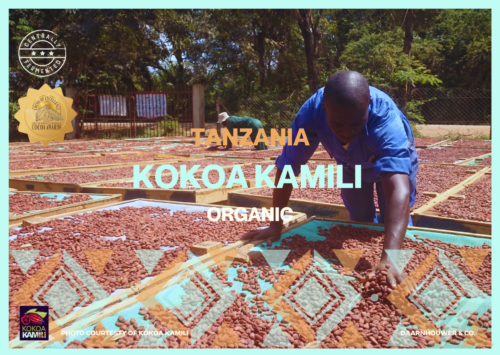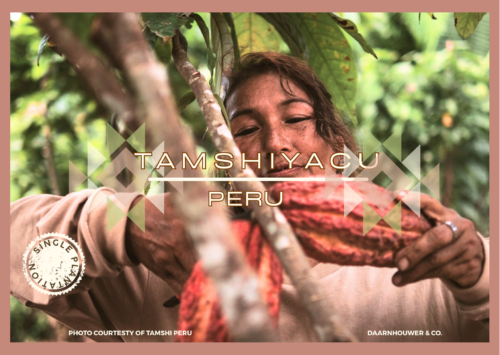Cocoa Beans
-
 After the Portuguese introduced cacao to Principe, the small island became the gateway of cacao to Africa. From there cacao was brought to its sister island of São Tomé and later on into mainland West Africa. The bittersweet history of cacao on both islands was reflected in the neglect of plantations and crops for many decades. Nowadays, it has regained strength and has become an important source of income for many smallholder farmers who are proud of their contribution to the country's production.
After the Portuguese introduced cacao to Principe, the small island became the gateway of cacao to Africa. From there cacao was brought to its sister island of São Tomé and later on into mainland West Africa. The bittersweet history of cacao on both islands was reflected in the neglect of plantations and crops for many decades. Nowadays, it has regained strength and has become an important source of income for many smallholder farmers who are proud of their contribution to the country's production. -
 After the Portuguese introduced cacao to Principe, the small island became the gateway of cacao to Africa. From there cacao was brought to its sister island of São Tomé and later on into mainland West Africa. The bittersweet history of cacao on both islands was reflected in the neglect of plantations and crops for many decades. Nowadays, it has regained strength and has become an important source of income for many smallholder farmers who are proud of their contribution to the country's production.
After the Portuguese introduced cacao to Principe, the small island became the gateway of cacao to Africa. From there cacao was brought to its sister island of São Tomé and later on into mainland West Africa. The bittersweet history of cacao on both islands was reflected in the neglect of plantations and crops for many decades. Nowadays, it has regained strength and has become an important source of income for many smallholder farmers who are proud of their contribution to the country's production. -
 With an annual cacao harvest averaging around 100-150 tons per year, Jamaica currently exports about 90% of its annual production. Until recently, the beans underwent a "polishing" process that gave them a unique outward appearance. This process is no longer used on the beans but the richness and depth of flavours remains.
With an annual cacao harvest averaging around 100-150 tons per year, Jamaica currently exports about 90% of its annual production. Until recently, the beans underwent a "polishing" process that gave them a unique outward appearance. This process is no longer used on the beans but the richness and depth of flavours remains. -
 Since its foundation, Kokoa Kamili has had a deep commitment to benefitting the farmers it works with and to quality. Their cocoa beans are found in award winning chocolate bars, couvertures and chocolate products around the world. Kokoa Kamili earned a much coveted spot amongst the world's 18 best cacaos at the 2017 edition of the Cacao of Excellence Awards.
Since its foundation, Kokoa Kamili has had a deep commitment to benefitting the farmers it works with and to quality. Their cocoa beans are found in award winning chocolate bars, couvertures and chocolate products around the world. Kokoa Kamili earned a much coveted spot amongst the world's 18 best cacaos at the 2017 edition of the Cacao of Excellence Awards. -
 After the Portuguese introduced cacao to Principe, this small West African island became the gateway of cacao to the mainland. From Principe, cacao trees were introduced to its sister island of São Tomé and later brought to Ghana. The bittersweet history of cacao on both islands was reflected in the neglect of plantations and crops for many decades. Nowadays, it has regained strength and has become an important source of income for many smallholder farmers who are proud of their contribution to the country's production.
After the Portuguese introduced cacao to Principe, this small West African island became the gateway of cacao to the mainland. From Principe, cacao trees were introduced to its sister island of São Tomé and later brought to Ghana. The bittersweet history of cacao on both islands was reflected in the neglect of plantations and crops for many decades. Nowadays, it has regained strength and has become an important source of income for many smallholder farmers who are proud of their contribution to the country's production. -
 Through extensive genetic studies, the origin of the different Theobroma species was determined to be located in the Upper Amazon Valley which comprises parts of Peru, Colombia, Ecuador, Venezuela and Brazil. This rich diversity lives on to our current days and is showcased by each one of these countries. Tamshiyacu showcases excellent cacao from the heart of the Peruvian Amazon by combining innovative agrofrorestry systems and land restoration.
Through extensive genetic studies, the origin of the different Theobroma species was determined to be located in the Upper Amazon Valley which comprises parts of Peru, Colombia, Ecuador, Venezuela and Brazil. This rich diversity lives on to our current days and is showcased by each one of these countries. Tamshiyacu showcases excellent cacao from the heart of the Peruvian Amazon by combining innovative agrofrorestry systems and land restoration.







